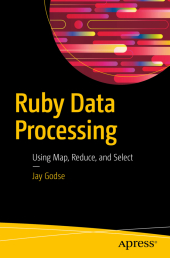 Neuerscheinungen 2018Stand: 2020-02-01 |
Schnellsuche
ISBN/Stichwort/Autor
|
Herderstraße 10
10625 Berlin
Tel.: 030 315 714 16
Fax 030 315 714 14
info@buchspektrum.de |

Jay Godse
Ruby Data Processing
Using Map, Reduce, and Select
1st ed. 2018. xv, 98 S. 1 Farbabb. 235 mm
Verlag/Jahr: SPRINGER, BERLIN; APRESS 2018
ISBN: 1-484-23473-1 (1484234731)
Neue ISBN: 978-1-484-23473-0 (9781484234730)
Preis und Lieferzeit: Bitte klicken
Gain the basics of Ruby´s map, reduce, and select functions and discover how to use them to solve data-processing problems. This compact hands-on book explains how you can encode certain complex programs in 10 lines of Ruby code, an astonishingly small number. You will walk through problems and solutions which are effective because they use map, reduce, and select. As you read Ruby Data Processing , type in the code, run the code, and ponder the results. Tweak the code to test the code and see how the results change.
After reading this book, you will have a deeper understanding of how to break data-processing problems into processing stages, each of which is understandable, debuggable, and composable, and how to combine the stages to solve your data-processing problem. As a result, your Ruby coding will become more efficient and your programs will be more elegant and robust.
What You Will Learn
Discover Ruby data processing and how to do it using the map, reduce, and select functions
Develop complex solutions including debugging, randomizing, sorting, grouping, and more
Reverse engineer complex data-processing solutions
Who This Book Is For
Those who have at least some prior experience programming in Ruby and who have a background and interest in data analysis and processing using Ruby.
1. Basic Ruby 2. Function Overview and Simple Examples 3. Complex Solutions 4. Reverse Engineering Complex Solutions
Jay Godse is an active software and web applications developer, with expertise in Ruby, Rails, PostgreSQL, Sidekiq, Slim, jQuery, and Ansible. He also is active on Stack Overflow as an active contributor. He graduated with an engineering degree, and then went to work as a digital circuit designer. After a year of that he switched to software development and has been there ever since in some form. His early work was mostly real-time telecommunication device control and provisioning using languages such as C and Protel. He then transitioned into designing distributed computing systems, using languages such as C++ and CORBA IDL. After that, transitioned into web applications. Along the way he did stints as a software development manager and a software architect. But for the last 7 years, he has written web applications.


